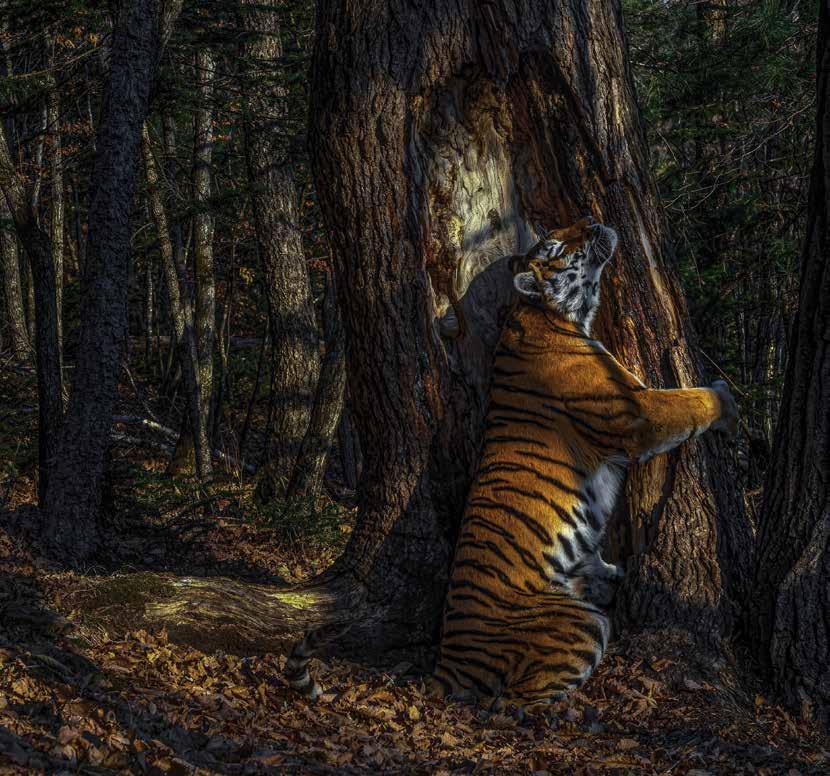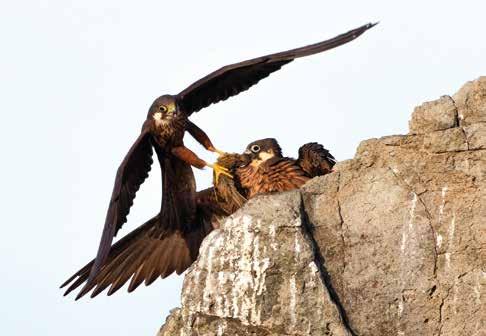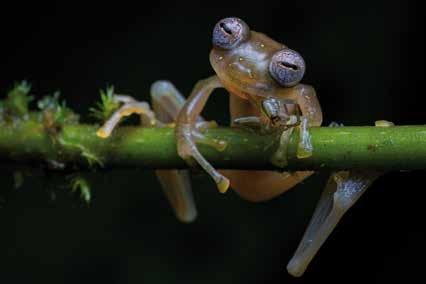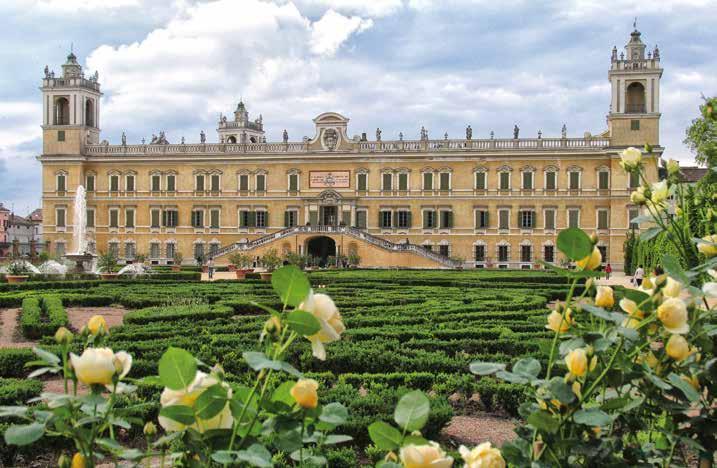
9 minute read
Nature through the lens Porcellane a Corte Court China 24
Che spettacolo la natura selvaggia
Ritorna il Wildlife Photographer of the Year, il più importante riconoscimento dedicato alla fotografia naturalistica promosso dal Natural History Museum di Londra. Ecco gli autori di alcuni degli scatti premiati, oggi in mostra in Italia al Forte di Bard Nature through the lens The Wildlife Photographer of the Year is the most important wildlife photography award in the world, sponsored by the Natural History Museum in London. An exhibition in Forte di Bard in Italy hosts some of the winning shots
Advertisement

Sergey Gorshkov
In alto: l’immagine vincitrice del Wildlife Photographer of the Year Above: the award-winning Wildlife Photographer of the Year shot
Alberto Fantoni
In alto: una delle immagini che hanno permesso al fotografo italiano di vincere il Rising Star Portfolio Award Above: one of the shots that earned the Italian photographer the Rising Star Portfolio Award
Gabriel Eisenband
I fiori delle Ande Flowers in the Andes

Anche nel 2021 il
Forte di Bard, in Val d’Aosta, ospiterà sino a fine agosto l’anteprima italiana della 56a edizione del Wildlife Photographer of the Year, concorso internazionale che ha visto in gara più di 49.000 scatti provenienti da fotografi naturalisti di tutto il mondo. Le immagini immortalano natura e animali non solo nella loro bellezza e diversità, ma anche nella loro fragilità, sottolineando l’importanza di difendere e salvaguardare il Pianeta. Vincitore del prestigioso titolo è il fotografo russo Sergey Gorshkov con “The embrace”. L’immagine ritrae una tigre siberiana, specie in via d’estinzione, che abbraccia un antico abete della Manciuria per marcare il territorio. Il fotografo ha impiegato oltre dieci mesi per riuscire ad immortalare questo scatto ottenuto grazie a fotocamere con sensore di movimento.
For another year running Forte di Bard
in Val d’Aosta hosts the Italian preview of the 56th edition of the Wildlife Photographer of the Year until the end of August 2021. This year the international competition saw more than 49,000 entries from naturalist photographers from all over the world. The shots immortalize nature and animals both in their beauty and diversity, and also in their fragility, underlining the importance

Jaime Culebras
La rana di Manduriacu, Ecuador Glassfrog, Ecuador
Kirsten Luce
La regina del circo, storie di cattività Queen of the circus, stories of captivity


Tra i vincitori anche due italiani: il fotografo Luciano Gaudenzio, con lo scatto “Etna’s River of Fire”, nella categoria Earth’s Environments, e il giovane fotografo Alberto Fantoni, vincitore, con le sue immagini, del Rising Star Portfolio Award. Hanno invece ricevuto la menzione speciale, in quanto parte delle cento immagini finaliste del concorso fotografico, altri cinque fotografi italiani: Domenico Tripodi (Categoria Under Water), Alessandro Gruzza (Categoria Earth’s Environments), Andrea Pozzi (Categoria Plants and Fungi), Andrea Zampatti e Lorenzo Shoubridge (Categoria Animals in their Environment). Immagini mozzafiato, quelle presentate nell’ambito del Wildlife Photographer of the Year, che, aldilà del loro impatto estetico, anno dopo anno mettono in luce quanto a rischio sia la fauna e la flora della Terra. Richiamandoci ad un maggior impegno globale in difesa della natura.
Info
Per conoscere date e orari di apertura della mostra, in relazione alle indicazioni governative in merito alla lotta al Covid, basta contattare l’Associazione Forte di Bard Tel. + 39 0125 833811 info@fortedibard.it www.fortedibard.it For exhibition dates and opening hours during the Covid-19 contact the Forte di Bard Association Tel. + 39 0125 833811 info@fortedibard.it www.fortedibard.it of defending and safeguarding the planet. Winner of this year’s prestigious title is Russian photographer Sergey Gorshkov with “The embrace”. Gorshkov’s winning photograph portrays a Siberian tiger, a species in danger of extinction, hugging an ancient Manchurian fir to mark its territory. It took the photographer over ten months to be able to capture this singular moment thanks to cameras with motion sensors. Two Italians are also among the winners this year, Luciano Gaudenzio, with a shot of “Etna’s River of Fire”, in the Earth’s Environments category, and young Alberto Fantoni, who won the Rising Star Portfolio Award. A special mention also went to five other Italian photographers, all on the list of the hundred finalist images in the competition: Domenico Tripodi (Under Water Category), Alessandro Gruzza (Earth’s Environments Category), Andrea Pozzi (Plants and Fungi Category), Andrea Zampatti and Lorenzo Shoubridge (Animals in their Environment Category). The breath-taking images from the Wildlife Photographer of the Year are both an exercise in aesthetics and a necessary reminder year after year of how much of the earth’s fauna and flora is at risk, urging a greater global commitment in defence of nature and its superb works.
In mostra alla Reggia di Colorno (Parma) le splendide ceramiche che nel ’700 adornavano la tavola dei Duchi Court China An exhibition at the Royal Palace of Colorno (Parma) features the superb china that once adorned the ducal tables in the 18th century
Porcellane a Corte

by ANTONELLA TEREO
Lucide e preziose, le
porcellane del Settecento in uso alla Corte di Parma accendono i riflettori sulle abitudini di un’epoca, in un appassionante percorso espositivo ospitato dalla Reggia di Colorno. Frutto di cinque anni di lavoro, di ricerca di oggetti unici, carteggi e ricette di archivio, la mostra “Adornamenti da tavola. Porcellane europee del ’700 per i Duchi di Parma” sceglie come scenario la residenza che indiscutibilmente rappresenta la “Versailles italiana” per eccellenza. L’esposizione (aperta dal 15 maggio al 19 settembre 2021) apre lo sguardo su una “manía” che aveva in particolare Luisa Elisabetta di Francia, consorte di Filippo di Borbone, una vera e propria passione per la porcellana, al punto di collezionare pezzi considerati unici nell’estetica e nella funzione già all’epoca. I temi decorativi erano antropomorfi, con uccelli o animali da cortile, tendenza che nel ’700 era già di moda fra papi e re, rendendo tali oggetti degli status symbol, veicoli del desiderio di ostentazione e vanità. Tra stucchi e camini nel piano nobile della Reggia, e fra arazzi e consolle, nella sala da pranzo progettata dall’architetto Ennemond Alexandre Petitot sorge anche una tavola che è il fulcro di tutta la mostra: essa celebra l’attenzione a
Versailles italiana
La Reggia di Colorno in tutto il suo fascino (foto Gigi Montali) Sotto, da sinistra, tre delle opere in mostra: Allegoria del fiume, Allegoria dell’Asia, Contadinella
The Italian Versailles
The Royal Palace at Colorno in all its splendour (photo by Gigi Montali) Below from the left, three of the works on display: River Allegory, Allegory of Asia, Peasant Girl
Reggia di Colorno: stufa del 1749 in maiolica bianca, con tralci di fiori policromi The Royal Palace of Colorno: white porcelain stove with garlands of polychrome flowers, 1749

speciali stoviglie e porcellane di numerosi servizi, da quelli decorati da roselline ad altri con scenari mitologici. Molte le curiosità fra quei set del corredo, come il servizio che conta alcune alzate per ostriche che per volere della duchessa di Parma - “Babette”, come la chiamava il padre Luigi XV, sovrano di Francia - entrano a far parte di una collezione già unica e realizzata appositamente per lei. Lei, che sceglieva l’oggettistica di Meissen, Sèvres, Vincennes, Chantilly, Doccia e Capodimonte, facendo così della propria residenza in Italia un prezioso scrigno. Ma la collezione testimonia anche il gusto di stare a tavola nel ’700; le porcellane segnano infatti un periodo storico in cui la stessa tavola cambia e si compone di più portate, più piccole e, quindi, caratterizzate da molti più oggetti, scelti persino in base alle pietanze, come fanno trapelare le marronières per i marron glacé o i piattini per tazze utilizzate per raffreddare le bevande calde. Dettagli che ci parlano delle consuetudini in voga in quel piccolo Ducato che per secoli ospitava una delle più raffinate corti europee.


Temi mitologici
Qui sopra: piatto con Bacco e Baccante Sotto: piatto con Diana ed Endimione In alto: coppia di zuppiere
Mythological motifs
Above: plate with Bacchus and Bacchante Below: plate with Diana and Endymion Top: pair of soup tureens
Gleaming and infinitely
precious, the porcelain used at the court of Parma in the 18th century highlights the lifestyle of a whole era, in a fascinating exhibition housed at the royal palace of Colorno. The result of five years of painstaking research into unique artefacts, records and ancient recipes, the exhibition “Tableware. European China in the 18th Century at the Court of the Dukes of Parma” is finally on display at the noble residence, which epitomises the Italian version of Versailles. The current exhibition (15 May-19 September) highlights a mania Louisa Elisabeth of France, wife of Philip of Bourbon, in particular, had for porcelain, collecting unique items considered masterpieces in her day from both an aesthetic and functional point of view. She was particularly fond of both farmyard themes and birds, a trend which was already wildly fashionable among 18th century kings and popes, turning such items into sought-after status symbols designed to ostentatiously proclaim their proud owners’ taste and power. Amidst the stuccoes and lavish fireplaces of the piano nobile of the royal palace, nestling among the tapestries and sideboards in the dining room designed by architect Ennemond Alexandre Petitot, is a table which represents the centrepiece of the whole exhibition. It celebrates those infinitely precious pieces of china pivotal to so many dining services, decorated with delicate rosebuds or scenes from mythology. There are a number of curiosities among the many pieces on display; for example the service which includes the raised serving dishes specially designed for oysters, which the Duchess of Parma, “Babette” as she was affectionately called by her father Louis XV of France, had insisted were included in a dining service exclusively commissioned for her personal use. Her Grace also adorned her court with carefully chosen pieces by Meissen, Sèvres, Vincennes, Chantilly, Doccia and Capodimonte, transforming her Italian residence into a treasure trove of precious porcelains. The collection bears mute witness to the changing style of dining that characterised the 18th century. The china reflects an historical period in which meals began to feature more numerous, and smaller, courses - all served on a dazzling array of dishes, some of them specifically designed to cater for certain foods, such as the marronières for marron glacé or the saucers once used to cool hot drinks. Details all eloquently portraying the society and manners pertaining to this diminutive duchy, which for centuries harboured one of the most refined courts in the whole of Europe.



